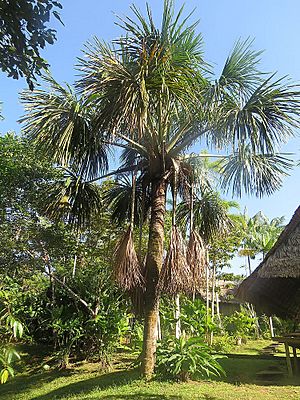Mauritia flexuosa facts for kids
Quick facts for kids Mauritia flexuosa |
|
|---|---|
 |
|
| Scientific classification | |
| Genus: |
Mauritia
|
| Species: |
flexuosa
|
| Synonyms | |
|
|
The moriche palm (scientific name: Mauritia flexuosa) is a tall palm tree. People also call it the ité palm, buriti, aguaje, or canangucho, depending on the country. This amazing tree grows in wet areas like swamps in tropical South America.
The moriche palm can grow very tall, sometimes up to 35 meters (about 115 feet) high. Its large leaves form a round top, like a big green crown. Yellow flowers appear on the tree from December to April. The fruit grows from December to June. It is a chestnut color and has shiny scales on the outside. Inside, the fruit has yellow flesh around a hard, oval nut. The seeds can float, which helps the tree spread to new places. Many moriche palms can grow close together in nature.
Contents
Delicious Moriche Palm Fruit
The fruit of the moriche palm is edible and very popular. In places like Peru, people harvest huge amounts of it every day. They use the fruit to make tasty things like juice, jam, and ice cream. You can also find a fermented drink, desserts, and snacks made from this fruit.
Besides the fruit, other parts of the tree are also used. The young flower buds can be eaten like a vegetable. The sap from the tree can be drunk fresh or fermented into a drink called "palm wine." Local people also use the tree's strong fibers to make threads and cords. Even some insects that live in the tree trunk are eaten by people.
Buriti Oil: A Special Oil
Buriti oil is a reddish-orange oil taken from the moriche palm fruit. This oil is special because it has a lot of good things in it. It contains high amounts of oleic acid, which is a healthy fat. It also has many tocopherols and carotenoids. Carotenoids are natural colors, and one important one in buriti oil is beta-carotene. This is the same thing that makes carrots orange! The oil's reddish color was even used as ink on animal hides in the past.
Moriche Palm and Animals
The moriche palm is super important for many animals. It's like a busy apartment building and a restaurant all in one! Many bird species, such as the red-bellied macaw and the moriche oriole, build their nests in these palms. They also eat the fruit.
Other animals like Tapirs, peccaries (wild pigs), fish, and monkeys also rely on the moriche palm's fruit for food. It's a vital part of their diet.
About 200 years ago, a famous explorer named Alexander von Humboldt traveled through Venezuela. He was amazed by how many living things depended on this one tree. He called the moriche palm the "tree of life" because it supported so much life around it.
The Moriche Palm in Brazil
The moriche palm is a common sight in central Brazil, especially in a type of grassland called the cerrado. The main government building in Brasília, the capital of Brazil, is even named after this tree. It's called Palácio do Buriti, which means "Buriti Palace." Right across from this building, there's a square with fountains and a single moriche palm tree. This tree was brought from outside the city and planted there, showing how important it is to the region.
See also
 In Spanish: Mauritia flexuosa para niños
In Spanish: Mauritia flexuosa para niños



